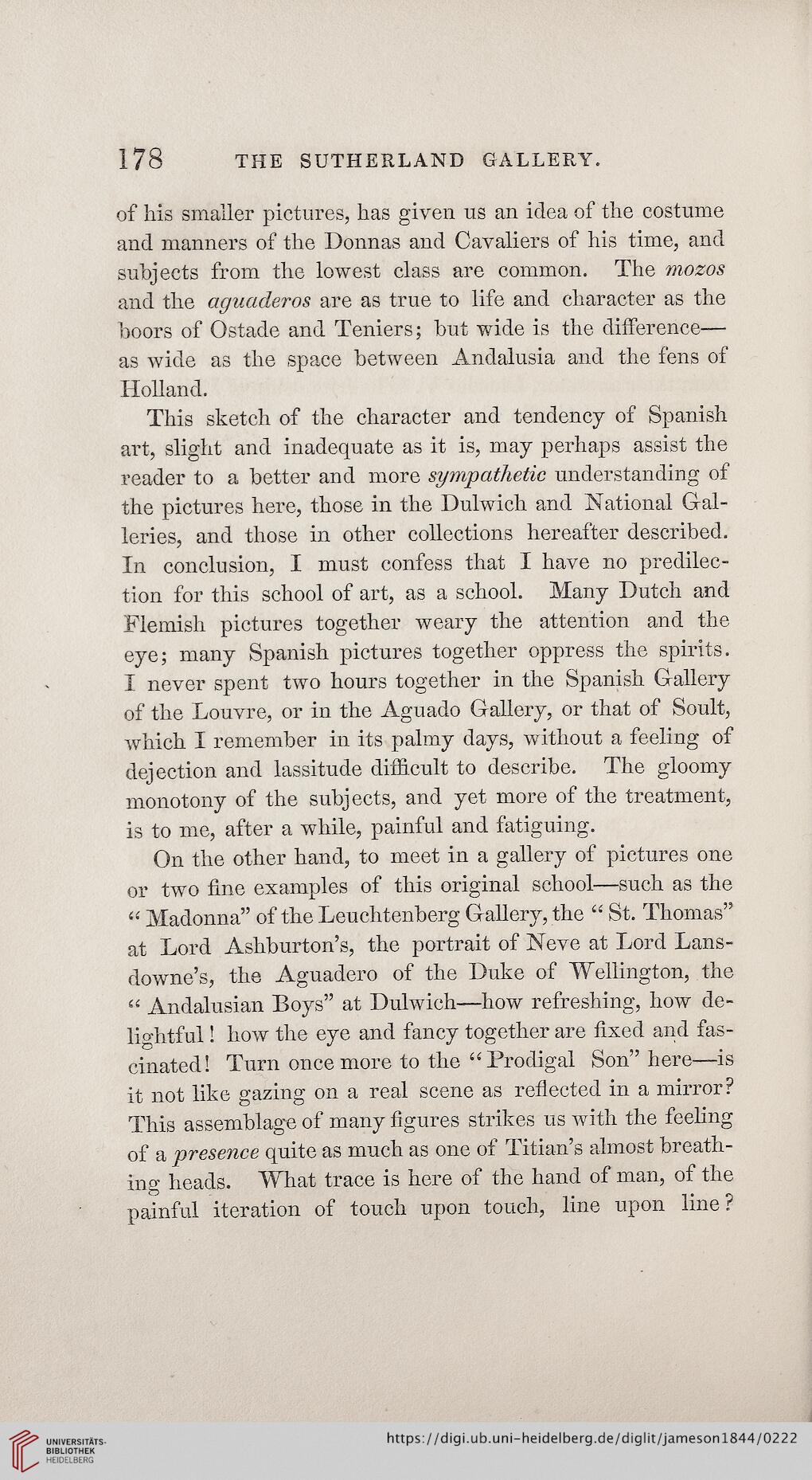178
THE SUTHERLAND GALLERY.
of his smaller pictures, has given us an idea of the costume
and manners of the Donnas and Cavaliers of his time, and
subjects from the lowest class are common. The mozos
and the aguaderos are as true to life and character as the
boors of Ostade and Teniers; but wide is the difference-
as wide as the space between Andalusia and the fens of
Holland.
This sketch of the character and tendency of Spanish
art, slight and inadequate as it is, may perhaps assist the
reader to a better and more sympathetic understanding of
the pictures here, those in the Dulwich and National Gal-
leries, and those in other collections hereafter described.
In conclusion, I must confess that I have no predilec-
tion for this school of art, as a school. Many Dutch and
Flemish pictures together weary the attention and the
eye; many Spanish pictures together oppress the spirits.
I never spent two hours together in the Spanish Gallery
of the Louvre, or in the Aguado Gallery, or that of Soult,
which I remember in its palmy days, without a feeling of
dejection and lassitude difficult to describe. The gloomy
monotony of the subjects, and yet more of the treatment,
is to me, after a while, painful and fatiguing.
On the other hand, to meet in a gallery of pictures one
or two fine examples of this original school—such as the
“ Madonna” of the Leuchtenberg Gallery, the “ St. Thomas”
at Lord Ashburton’s, the portrait of Neve at Lord Lans-
downe’s, the Aguadero of the Duke of Wellington, the
“ Andalusian Boys” at Dulwich—how refreshing, how de-
lightful ! how the eye and fancy together are fixed and fas-
cinated! Turn once more to the “Prodigal Son” here—is
it not like gazing on a real scene as reflected in a mirror?
This assemblage of many figures strikes us with the feeling
of a presence quite as much as one of Titian’s almost breath-
ing heads. What trace is here of the hand of man, of the
painful iteration of touch upon touch, line upon line ?
THE SUTHERLAND GALLERY.
of his smaller pictures, has given us an idea of the costume
and manners of the Donnas and Cavaliers of his time, and
subjects from the lowest class are common. The mozos
and the aguaderos are as true to life and character as the
boors of Ostade and Teniers; but wide is the difference-
as wide as the space between Andalusia and the fens of
Holland.
This sketch of the character and tendency of Spanish
art, slight and inadequate as it is, may perhaps assist the
reader to a better and more sympathetic understanding of
the pictures here, those in the Dulwich and National Gal-
leries, and those in other collections hereafter described.
In conclusion, I must confess that I have no predilec-
tion for this school of art, as a school. Many Dutch and
Flemish pictures together weary the attention and the
eye; many Spanish pictures together oppress the spirits.
I never spent two hours together in the Spanish Gallery
of the Louvre, or in the Aguado Gallery, or that of Soult,
which I remember in its palmy days, without a feeling of
dejection and lassitude difficult to describe. The gloomy
monotony of the subjects, and yet more of the treatment,
is to me, after a while, painful and fatiguing.
On the other hand, to meet in a gallery of pictures one
or two fine examples of this original school—such as the
“ Madonna” of the Leuchtenberg Gallery, the “ St. Thomas”
at Lord Ashburton’s, the portrait of Neve at Lord Lans-
downe’s, the Aguadero of the Duke of Wellington, the
“ Andalusian Boys” at Dulwich—how refreshing, how de-
lightful ! how the eye and fancy together are fixed and fas-
cinated! Turn once more to the “Prodigal Son” here—is
it not like gazing on a real scene as reflected in a mirror?
This assemblage of many figures strikes us with the feeling
of a presence quite as much as one of Titian’s almost breath-
ing heads. What trace is here of the hand of man, of the
painful iteration of touch upon touch, line upon line ?




